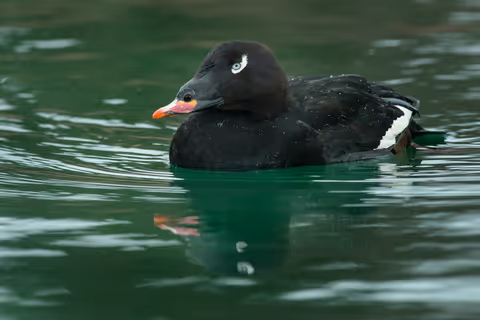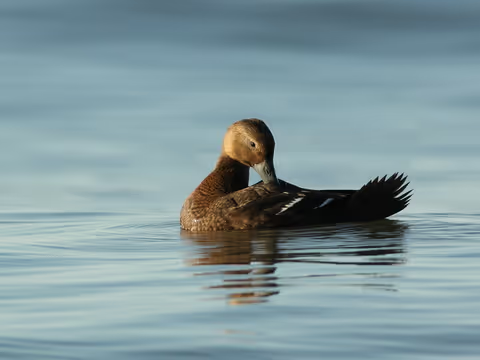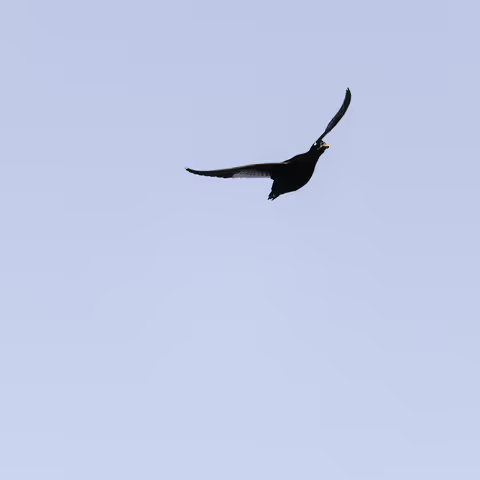White-Winged Scoters


When you think about a medium sized black bird, what comes to mind? Crows? They certainly fit the bill. However, they are not the only medium sized black birds who are worthy of your attention. Today, we're going to introduce you to one such species: the White-winged Scoter.

Appearance and Size
The White-winged Scoter (scientific name: Melanitta deglandi) is the largest member of the Scoter genus of sea ducks. They have stocky builds with long tails, thick necks, stout bills (males have a knob at the base of their bills, while females do not), and heavy heads which feature a sloped forehead. They also have very broad wings, which is evidenced by their 31.5 inch (80 centimeter) wingspan. White-winged Scoters are 18.9 to 22.8 inches long (48 to 58 centimeters), and weigh anywhere from 33.5 to 63.5 ounces (950 to 1,800 grams).
All White-winged Scoters have large, white patches on their wings. This is the only color pattern trait that males, females, and juveniles share, as adult males look very different from females and juveniles. Adult males are silken black in color across the majority of their bodies. Their wings have large, white patches on them. Adult males also feature a white mark around and behind their eye that resembles the shape of a comma. They have large, black feathers that extend onto their bills, which have an orange tip. Their feet are colored in a shade of bright orange-red. Adult females and juveniles have dark brown bodies and stomachs that are paler in color. They have dark colored bills, as well as a pair of white patches on their face that are notable for being "smudgy" (3).

Migration and Habitat
White-winged Scoters are migratory creatures, meaning that they do not spend the entire year in one place. In the winter, they can be found in the waters of the Pacific Ocean between San Diego and Alaska, the Atlantic Ocean between Labrador and Georgia, and in parts of the Gulf of Mexico between Texas and Florida. They particularly like to spend time in shallow water over shellfish beds. In the summer, White-winged Scoters can be found primarily in Alaska and Northwestern Canada near slow-moving rivers, ponds, and lakes that are located in open country. During the spring and fall migration seasons, they are a common sight across the Great Lakes and the waters between Northern Quebec and Atlantic Canada.
Flocks of White-winged Scoters typically fly at low altitudes over the ocean in wavering, long lines. During migration, they sometimes fly at higher altitudes, and may unexpectedly drop hundreds of feet with a loud rushing noise, should they see fit. On the water, they are normally quiet creatures that make little, if any noise.
Diet and Feeding Behavior
White-winged Scoters forage for their food. They do this by diving and swimming underwater. They primarily use their feet to propel them, but also partly spread their wings out to help them maneuver and thrust. Their diet is primarily made up of mollusks. However, they supplement that with crustaceans, sea lettuce, pondweeds, aquatic insects, and the occasional fish or two. They will swallow small items that they catch underwater. Large mollusks are treated with far less dignity, being carried to the surface and swallowed whole upon arrival.

Courtship and Nesting
During courtship, which normally occurs during the winter months, several males may surround one female and compete for her attention. They compete by putting on displays and pursuing them in short, underwater chases. Once a pair is formed, nesting activity begins. This normally occurs in late June and early July, which is late when compared to other bird species that begin their nesting activity earlier in the spring. The area where the female White-winged Scoter was hatched is the area that the pair will build their nest in, as the female has a very strong bond the place where they hatched and nesting. This bond is known “natal philopatry" (2). Nests are located on the ground in patches of thick brush that are typically close to a body of water. The nest is a shallow depression lined with down. Sometimes, plant material is added to provide additional lining.
Eggs and the Young
White-winged Scoters typically lay between nine and ten eggs. The eggs are pinkish or pale buff in color. Incubation is handled exclusively by the female, and takes approximately one month to complete. While the female has to leave the nest, she covers the eggs with down to try and hide them from predators. Shortly after they hatch, the young will leave the nest. They are tended to and brooded by the female while they are small, but are responsible for feeding themselves. The age of their first flight is not well known. The Audubon Society and My Edmonds News have both suggested that it takes place anywhere from seven to eleven weeks after hatching (1, 4). However, more research is needed to narrow down when exactly this milestone occurs.
References
© Ian D. Caldwell, April 2022
Touch whale bones, examine shipwreck artifacts and connect with the coast's living history.

Support our mission, get involved in educational programs, or contribute through donations and volunteering.